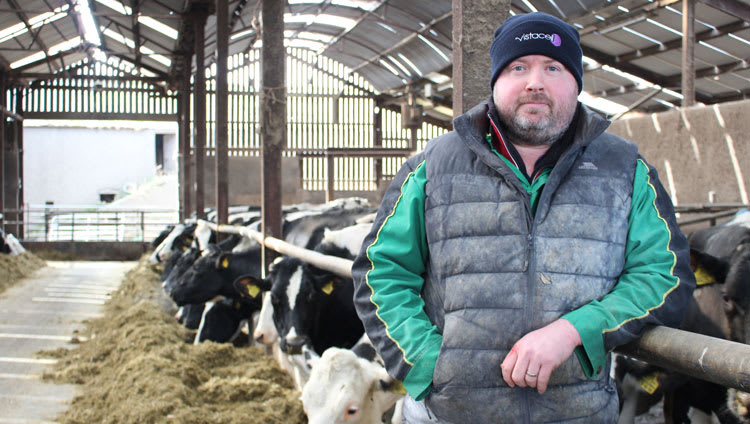Maximising rumen efficiency is critical in the drive for high yields from forage
Published Tuesday, 3rd January 2017
For Northern Ireland dairy farmer Andrew Reid, optimising rumen fermentation efficiency is an integral part of a feeding strategy that’s seen annual yields hit 10,000 litres/cow, butterfats at 4.11% and all on a system using grass as the primary forage.
“The only way to keep yields this high and maintain butterfats is to make sure the rumen spends as much time as possible working as efficiently as possible,” he explains.
Balancing the ration
“At this level of production you simply can’t cut corners, and in addition to paying close attention to the balance of the ration, using a live yeast and slow release rumen conditioner has been essential to keep the rumen environment optimised.
“We use Vistacell yeast, and if you take it out, you’ll see a clear drop in yield that’ll take at least a month to get back. It might look like you’re saving money, but it’s a false economy in the long run, and the same holds true for the Acid Buf rumen conditioner we also include in the milking ration.”
Based at Laurel Hill Farm, Lisburn, in County Antrim, the 200 Holstein Friesians are fed as one group during lactation, with the year-round total mixed ration (TMR) based on a combination of grass silage, straw, soyabean meal, maize meal and soya hulls.
“We’re also aware of the potential for any mycotoxins in the feed to undermine cow health and performance, so we include the mycotoxin de-activator Ultrasorb R as an insurance to help ensure the cows are always working at maximum efficiency,” Mr Reid adds.
A team effort
Nutrition advice is provided by Gareth Anderson from Farmgate Nutrition, who also analyses silages monthly to ensure rations can be quickly adjusted to maintain a consistent nutrient supply to the cows. Together with Andrew, his father Nelson and two full time employees, it’s a team that has steadily fine-tuned the herd’s nutrition over the years to optimise rumen function and feed efficiency.
“We also put a lot of focus on the dry cows – I believe a good transition is key to producing a 10,000 litre cow,” Andrew continues. “Dry cows are fed a high volume, low energy density ration formulated to optimise the rumen ready for lactation.
“That includes the yeast and mycotoxin de-activator to ensure conditions in the rumen are already as stable and efficient as possible when we need the cow to perform post-calving.”
To keep potassium levels low and minimise milk fever problems, haylage for the dry cows is made from pastures that receive no slurry. There’s been just one case of milk fever in the past two years, and the number of displaced abomasums is down to 3 per 250 calvings.
Pushing for performance first
“Be more efficient before you push for expansion, that’s our strategy. So we’ll push for better yields before increasing cow numbers, whilst also improving fertility and keeping on top of health problems.
“You’ve invested for years in genetics capable of producing 10,000 litres and above, so why not invest a little more in the feeds and supplements needed for the cow to deliver that performance. Getting the nutrition wrong for these higher genetic merit cows by cutting corners will cost us much more in the long run," Andrew concludes.
Latest news
Stay ahead with the latest news, ideas and events.

Online Feed Fibre Calculator
Calculate the percentage of dietary fibre in your feed
Our calculator is designed for nutritionists and uses averages of global raw materials to calculate the dietary fibre content (plus other more in-depth fibre parameters) of finished animal feed. These parameters are available within AB Vista’s Dietary Fibre analysis service (part of our NIR service).
Sign up for AB Vista news
A regular summary of our key stories sent straight to your inbox.
SUBSCRIBE© AB Vista. All rights reserved 2025
Website T&Cs Privacy & Cookie Policy Terms & Conditions of Sale University IDC policy Speak Up Policy
























